In a burial chamber deep within a South African cave system, a team of scientists has discovered partial skeletons — of a completely new human-like species

Johannesburg: Scientists have discovered a new species in the human family tree — a small creature with a tiny brain — after examining a huge haul of fossilised bones found in a dark chamber of a South African cave, raising intriguing questions about our evolutionary past.

The species, found in the cave, shows a surprising mix of human-like and more primitive features. Researchers believe that the bodies appear to have been deposited in the cave intentionally. Pics/AFP
ADVERTISEMENT
Largest fossil hominin
The discovery of fossils of 15 individuals, consisting of 1,550 bones, represents the largest fossil hominin find on the African continent. The finding also indicates that these individuals may have been capable of ritual behaviour. “We found adults and children in the cave who are members of genus Homo but very different from modern humans.

They are very petite and have the brain size of chimpanzees,” said Charles Musiba, associate professor of anthropology at University of Colorado, Denver. The discovery was made inside the Rising Star Cave in the Cradle of Humankind World Heritage Site in South Africa.
“The hand has human-like features for manipulation of objects and curved fingers that are well adapted for climbing,” said Caley Orr, assistant professor at the University of Colorado School of Medicine.
‘Naledi’ means ‘star’
The new species has been dubbed Homo naledi after the cave where it was found —‘naledi’ means ‘star’ in the local South African language Sesotho. The bodies appear to have been deposited in the cave intentionally in a burial chamber, the researchers said.
The team of 35 to 40 scientists was led by Lee Berger, research professor in the Evolutionary Studies Institute at the University of Witwatersrand in South Africa. “There are potentially hundreds if not thousands of remains of Homo naledi still down there,” said Berger.
The exact position of the species in our family tree is unknown, researchers said. There is an assumption that any new group of fossils must belong to an existing species. The study suggests that Homo naledi most closely resembles Homoerectus with its small brain and body size. The researchers still do not know the exact age of the fossil site.
 Subscribe today by clicking the link and stay updated with the latest news!" Click here!
Subscribe today by clicking the link and stay updated with the latest news!" Click here!







